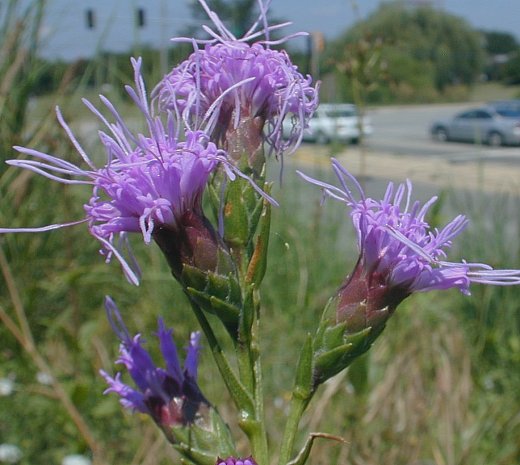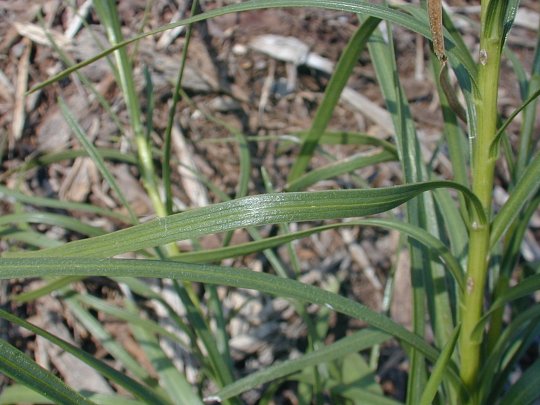Description: This herbaceous perennial plant is 1–1½' tall and unbranched. The central stem is largely hairless, except for a few hairs near the inflorescence. The leaves are up to 8" long and 1/3" (8 mm.) across, becoming smaller and fewer as they ascend the stem. These leaves appear whorled because of their density, but they actually alternate around the stem.

They are linear,
sessile, and hairless, while their margins are smooth. A short
spike-like raceme of compound flowers about 2-4" long occurs at the top
of the stem. They are pink or purplish pink, and quite showy. A
compound flower consists of about 15-25 tubular flowers that are
crowded together into a head spanning about 1" across. Each flower has
5 small lobes that curl outward, while a divided style protrudes from
the center. This style is white or pinkish white, and rather long and
curly. Each compound flower is subtended by green bracts that form a
smooth, cylindrical surface about 1½" long. The blooming period is mid-
to late summer, and lasts about a month. There is no floral scent. The
achenes later develop bristly hairs that aid in their dispersal. The
root system consists of a corm, which may occasionally produce offsets.
Cultivation:
The preference is full sun, poor soil, and dry conditions. This plant
often grows on hills or slopes amid rocky material, but it also
tolerates loamy soil if the site is well-drained. Drought tolerance is
excellent, and foliar disease is not a significant problem at most
locations. This plant doesn't compete well against taller, more
aggressive plants on fertile soil where there is level ground.

Range &
Habitat:
The native Cylindrical Blazingstar is a fairly uncommon plant that
occurs
primarily in northern and western Illinois (see Distribution
Map). It is rare or absent in other areas. Habitats include
dry upland areas of black soil prairies, hill prairies, openings in
rocky upland woods, oak savannas, limestone glades, rocky bluffs and
cliffs along major rivers, moist sand flats near Lake Michigan, and
shoulders of highways. This plant is typically found in marginal areas
that are little disturbed by modern development.
Faunal Associations:
The flowers are visited primarily by long-tongued bees, butterflies,
skippers, and bee flies. Some short-tongued bees may visit the flowers
to collect pollen, but they are not effective pollinators. The
caterpillars of the rare Schinia gloriosa (Glorious
Flower Moth) feed on the flowers and seed capsules of this and other Liatris
spp. Mammalian herbivores readily consume all parts of this
plant, including rabbits, groundhogs, deer, and livestock. Prairie and
Meadow Voles sometimes eat the corms. An overpopulation of these
animals can make the establishment of this plant difficult in some
areas.

Photographic
Location:
The photographs were taken at a wildflower garden near the Red Bison
Railroad Prairie in Champaign, Illinois.
Comments:
This is another lovely Blazingstar; it is much shorter than most of the
others, and tends to bloom earlier. Cylindrical Blazingstar is easy to
identify because of the smooth cylindrical surface formed by the green
bracts subtending the flowers; this cylindrical surface is longer and
larger than what is encountered in other Blazingstars that occur in
Illinois. Amerindians would sometimes eat the corms of Blazingstars,
although this was considered starvation food.